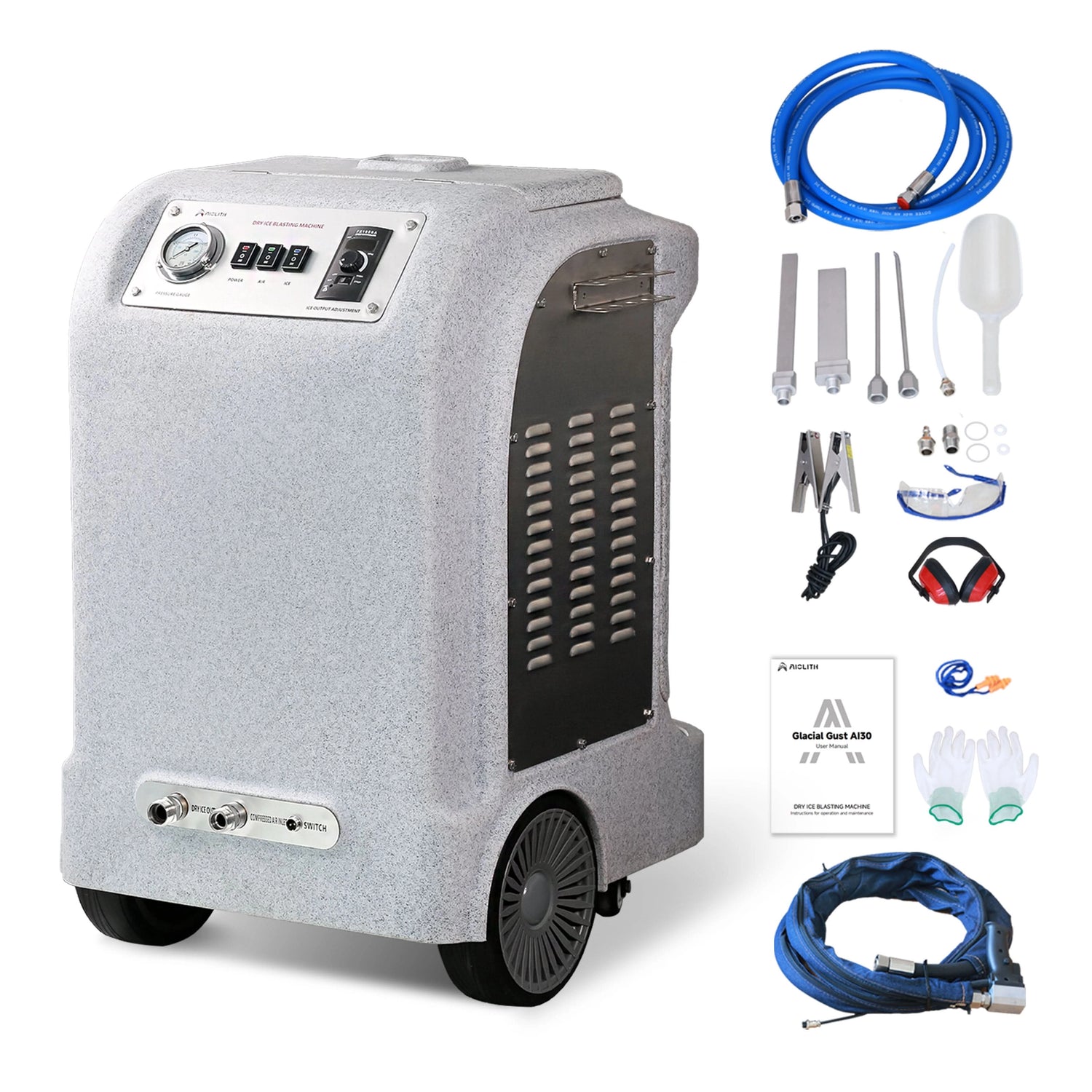Cut Operating Costs by Up to 70% in 5 Years with Lithium Power
Share
Every facility manager and building service contractor faces the same daily challenge: keep floors clean and safe while staying within tight budgets.
On the surface, the machines themselves look like the biggest expense. But seasoned operators know that the real cost of cleaning equipment lies in its batteries.
Batteries determine not just how long a scrubber can run, but how much you spend on replacements, energy, labor, and downtime over the machine’s life. For decades, lead-acid technology—whether flooded, AGM, or gel—was the only option. Today, lithium-ion (LiFePO4) batteries are rewriting the economics of floor scrubbers.
While lithium scrubbers cost more upfront, the data is clear: over a 5-year period, they can reduce operating costs by as much as 70%. Here’s how.
The True Cost of Lead-Acid Batteries
1. Lower Purchase Price, Higher Long-Term Expense
A typical 22-inch walk-behind scrubber powered by AGM lead-acid batteries may list at around $3,499, compared to about $5,299 for a lithium model. That looks like a $1,800 savings. But within the first few years of ownership, those savings disappear.
2. Frequent Replacements
AGM and gel lead-acid batteries deliver 300–700 cycles. In daily use, that equals only 2–3 years before capacity fades below usable levels. Over a 5-year period, you’ll need two to three replacement packs. Each 24V pack costs roughly $1,200 installed, so replacements add $2,400–$3,600 to your operating costs.
Lithium (LiFePO4), by contrast, routinely delivers 2,000+ cycles—more than 5 years of daily use—without replacement. Many lithium packs outlast the scrubber itself.
3. Maintenance Labor
Even though AGM and gel batteries reduce watering, they still require periodic inspections, equalization charging, and terminal cleaning. Flooded lead-acid requires even more attention. In a U.S. facility, where janitorial labor averages $17–$25 per hour, spending even 30 minutes per week on battery care equates to 26 hours per year—or roughly $3,250 over 5 years.
Lithium batteries require zero maintenance. No watering, no corrosion, no venting.
4. Downtime Costs
Charging lead-acid batteries is slow: 8–10 hours for a full charge, plus a cooldown period. Machines often sit idle overnight or through a full shift. In high-intensity facilities, downtime can add up to 60 hours per year. At a $25/hour fully loaded labor rate, that equals $7,500 in lost productivity over 5 years.
Lithium recharges to 80–90% in 2–3 hours and supports opportunity charging. Machines can be plugged in during breaks and lunches, ensuring they’re always ready. That translates into zero downtime cost.
5. Energy Efficiency
Lead-acid batteries are 80–85% efficient. Lithium reaches ≈95% efficiency. For a scrubber that consumes about 2 kWh per cycle, run 1,500 cycles over 5 years, the difference in wasted electricity adds up. At the U.S. average rate of $0.1317/kWh, electricity costs are roughly $1,640 for lead-acid versus $1,430 for lithium.
6. Facility and Disposal
Lead-acid requires ventilated charging rooms and regulated disposal. Over 5 years, that adds around $600 in facilities and end-of-life costs. Lithium is sealed, clean, and requires only a $50 disposal fee.
Five-Year TCO: Side-by-Side
| Cost Category | Lithium (A7) | Lead-Acid (AGM/Gel) |
|---|---|---|
| Initial Machine | $5,299 | $3,499 |
| Battery Replacements | $0 | $3,600 |
| Maintenance Labor | $0 | $3,250 |
| Downtime Cost | $0 | $7,500 |
| Energy Consumption | $1,430 | $1,640 |
| Facilities & Disposal | $50 | $600 |
| 5-Year Total TCO | $6,779 | $20,089 |
Result: Lithium saves approximately $13,310 in 5 years, cutting operating costs by 66%. In facilities with higher labor rates or more frequent replacements, savings reach 70%.
Ten-Year Perspective
Looking at 10 years—the lifespan many facility managers use for capital planning—the gap is even more pronounced.
- Lead-acid scrubbers may need 4–6 battery replacements, costing $6,000–$7,200.
- Add $6,500 in maintenance labor and at least $1,600 in downtime, plus energy waste, and total TCO climbs above $18,000–$20,000.
- Lithium machines typically stay below $8,000–$9,000 over the same period.
That’s a 61–65% savings across a full decade of use.
Why Facility Managers Choose Lithium
- More uptime: Crews finish on schedule without waiting for batteries.
- Simpler operations: No watering, no venting, no charging rooms.
- Safer workplaces: No acid spills, fumes, or corrosion.
- Greener footprint: Longer life means fewer batteries manufactured, transported, and disposed.
- Predictable budgets: One battery purchase covers the entire 5-year cycle.
Conclusion
AGM and gel batteries improved upon traditional flooded designs, but they cannot compete with lithium when measured by total cost of ownership. Lithium delivers:
- No replacements in 5 years
- Zero maintenance labor
- Faster charging, lower energy waste
- Consistent power and uptime
Yes, the upfront cost is higher. But over 5 years, lithium scrubbers reduce operating costs by up to 70%. Over 10 years, the savings remain above 60%. For facility managers, this isn’t just about technology—it’s about protecting budgets, increasing productivity, and ensuring consistent, reliable cleaning.
Stop paying for hidden costs. Switch to lithium, and turn your scrubber from an expense into a long-term asset.
FAQs
Q1. Aren’t AGM or gel lead-acid batteries already maintenance-free?
AGM and gel batteries reduce the need for watering, but they are not truly maintenance-free. They still require inspections, equalization charging, and periodic cleaning of terminals. Over time, sulfation and reduced cycle life remain issues. Lithium batteries are 100% maintenance-free—no watering, no venting, no acid handling.
Q2. How much longer do lithium batteries last compared to AGM or gel?
Typical AGM/gel batteries deliver 300–700 cycles, which translates to 2–3 years of daily use. Lithium iron phosphate (LiFePO4) batteries deliver 2,000+ cycles, often lasting 5–8 years or more. In many cases, a single lithium pack will last the entire life of the scrubber.
Q3. Why is downtime such a big deal for cleaning operations?
Every hour a scrubber is charging instead of cleaning costs money. Lead-acid batteries take 8–10 hours to fully recharge and often require cooldown. Lithium batteries charge to 80–90% in just 2–3 hours and allow “opportunity charging” during breaks. That means machines are available when crews need them, reducing downtime cost to zero.
Q4. Is the energy savings from lithium really significant?
Yes. Lead-acid is only about 80–85% efficient, while lithium is around 95%. For a scrubber running 1,500 cycles in 5 years at 2 kWh per cycle, that’s a difference of more than 200 kWh wasted electricity—equal to about $200 in extra energy cost at U.S. average rates. While energy savings aren’t the biggest line item, they reinforce lithium’s efficiency advantage.
Q5. Lithium machines cost more upfront—why pay extra?
Because the upfront difference (~$1,800 on a typical 22-inch scrubber) is dwarfed by the long-term savings. Over 5 years, lithium avoids $3,600 in battery replacements, $3,250 in labor, $7,500 in downtime, and $550 in extra energy and disposal costs. That equals more than $13,000 in savings, or about 66–70% lower TCO.
Q6. Are lithium batteries safe?
Yes. Lithium iron phosphate (LiFePO4) is one of the safest lithium chemistries. It is thermally stable, non-toxic, and does not release hazardous gases. Unlike lead-acid, there is no risk of acid spills or corrosion. Many packs also include built-in Battery Management Systems (BMS) for overcharge and short-circuit protection.
Q7. How does lithium impact sustainability goals?
Lithium batteries last longer, which means fewer batteries need to be manufactured, shipped, and disposed. Over 10 years, one lithium pack can replace up to 6 lead-acid packs, reducing raw material use and hazardous waste. For organizations with ESG targets, lithium supports both environmental and financial goals.
Q8. What kind of facilities benefit most from lithium scrubbers?
High-duty environments—airports, hospitals, warehouses, schools, and retail centers—see the fastest payback because downtime and maintenance costs are high. But even smaller facilities benefit from lower maintenance and the peace of mind of having machines that “just work” every day.

